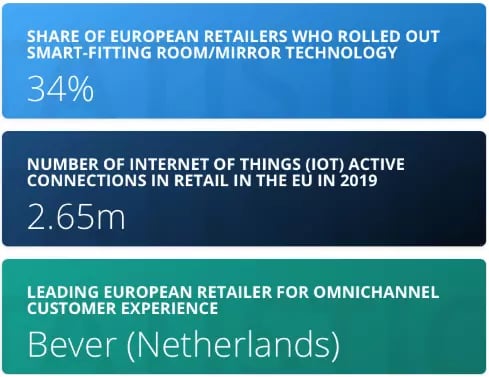If you recently took a walk through a nearby store (and I’m sure you did), you most certainly noticed the same in-store marketing and merchandising techniques: display booths, product sampling, shelf stoppers, TV screens and the good-old friend in-store radio.
Well, take a good look around, because the retail industry is facing some major changes in 2020 and, at the end of the year, you might not recognize your neighborhood supermarket anymore.
At the moment of publishing this article, the CoVid-19 outbreak is disrupting and changing many industries, including retail. There is a surge in demand for basic necessity products, such as food and hygiene items, however other retail sectors have experienced the opposite. While we cannot predict the future, especially in uncertain times, the trend of increased technology use will still change the face of retail.
Consumer adoption of digital technologies is bound to transform not only the online shops, but also brick-and-mortar stores. Well, I dare to say...especially brick-and-mortar stores. Because in spite of the rise in e-commerce sales, recent studies show that people spend more when shopping in-store than online.
That’s good news! But it also puts pressure on traditional retailers. If people are spending more in stores, then why aren’t they spending that much in your store?
Don’t despair. If you’re looking for brick-and-mortar marketing trends that can help you increase retail sales and keep you ahead of the game, we’ve got you covered.
The great news is that there is a recipe for success and we all know the main super-special ingredient, which is...take a wild guess! YES – retail technology.
A survey conducted in the UK showed that in-store digitalization is praised both by retail employees and customers. Employees use retail technology such as smart checkouts, mobile stock monitoring apps and other devices to offer better service to their customers.
"A survey conducted in the UK showed that in-store digitalization is praised both by retail employees and customers."
CLICK TO TWEET
Customers, on the other hand, said they would love to see more retail technology like smart mirrors, VR and personalization in the near future. JACKPOT! We’ve got ourselves a winner.

In this case, which are the innovative technologies you should focus on, in order to increase retail sales and generate more customer satisfaction and loyalty? Let’s go through our favorites:
1. Augmented and Virtual Reality
AR and VR are on the rise and retailers are expected to find new ways of using these technologies to fulfill their customers’ needs. Go beyond the gamification and fun experiences AR is designed to create, and take it to the next level: the one where AR/VR can help your customers browse facilities and catalogs or build routes inside the store to make shopping more effective.
Use this retail technology to create navigation assistance for instance, speed up the shopping experience and increase your in-store sales.
2. Indoor Location-Based Services (LBS)
This trend will take retail shopping to a whole new level. Location-based technology is trying to support the store’s constant need of recognizing customers’ shopping behavior. Solutions so far offer 3D laser scanning carts, mobile solutions for analyzing digital building panoramas and navigation toolkits for indoor 3D mapping.
Location-based services are meant to improve the customer’s journey in brick-and-mortar stores by offering relevant information and personalized special offers. For example, when clients walk by a product, they are provided directions to make the shopping process smoother and more efficient.
3. The Power of Omnichannel
This term has been going around in retail circles for a while and let’s be honest, it’s the future of the retail industry. Customers ask for a single shopping experience, because they don’t distinguish between online and offline shopping anymore. Most of them start shopping in one and proceed to checkout in another.
This requires retailers to have a 360-degree view of the customer and identify shopping behaviors, patterns and preferences in order to stay connected to their consumers at all times. AR and VR technologies can help retailers achieve this, but they’re not the only ones.
Loyalty apps, face recognition solutions and personalization should be on your list when creating a unique and consistent shopping journey for your customers.
4. Experience over Convenience
Nowadays, customers don’t want to buy a product, they want to be part of a story. While remodeling your store can be a good idea, in 2020 you’ll have to raise the stakes a little higher.
Nike and Ikea have been experimenting with concept stores to offer a limited stock of items for instance. Walmart sponsored Jurassic World’s AR game, offering to hunt and capture dinosaurs in their stores.
Bottom line is that the retail industry must consider delivering more engaging activities to make the shopping experience memorable to its clients.
5. Keep it Simple and Efficient
While all of the above can be overwhelming, there are retail technologies that are easier to implement and drive immediate results. If you’re looking to increase customer engagement at the point of sale and offer a unique shopping experience to your customers, you can rely on Tokinomo – a smart robot that makes products talk, move or even dance on the shelf. This solution does not only help you tell the brand’s story inside a supermarket, but it’s also the most effective way to skyrocket your retail sales in just a few days.
Conclusion
From mobile apps that make your employees more efficient and happy, to retail technology that keeps your customers showing up and wanting more, retail is changing. The key takeaway is that digitalization is taking over brick-and-mortar marketing and that, in order to remain competitive in a sea of product-providers, you must be an experience-provider.
Take the existing technologies and spin them around so they can perfectly fit your customers’ needs. Play by the rules to remain in the game, or change the rules to win the game.



